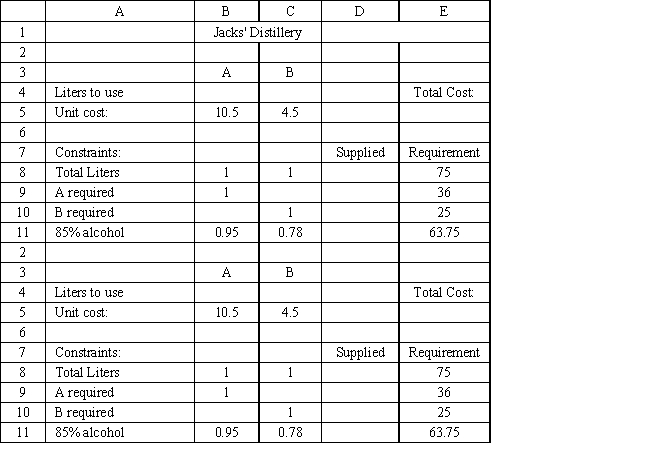Exhibit 3.3
The following questions are based on this problem and accompanying Excel windows.
Jack's distillery blends scotches for local bars and saloons. One of his customers has requested a special blend of scotch targeted as a bar scotch. The customer wants the blend to involve two scotch products, call them A and B. Product A is a higher quality scotch while product B is a cheaper brand. The customer wants to make the claim the blend is closer to high quality than the alternative. The customer wants 50 1500 ml bottles of the blend. Each bottle must contain at least 48% of Product A and at least 500 ml of B. The customer also specified that the blend have an alcohol content of at least 85%. Product A contains 95% alcohol while product B contains 78%. The blend is sold for $12.50 per bottle. Product A costs $7 per liter and product B costs $3 per liter. The company wants to determine the blend that will meet the customer's requirements and maximize profit. 

-Refer to Exhibit 3.3. Which of the following statements could represent a constraint in this problem?
A) B4:C4 ≤ B5:C5
B) E5 ≤ 0
C) D8 = E8
D) E8:E11 ≤ D8:D11
Correct Answer:
Verified
Q3: The LHS value of a constraint represents
Q4: Which type of spreadsheet cell represents the
Q5: Decision variables are sometimes referred to as
Q6: Solving LP problems in Excel requires only
Q7: Using Data Envelopment Analysis (DEA) for an
Q9: Exhibit 3.5
The following questions are based on
Q10: What does the Excel "=SUMPRODUCT(A1:A5,C6;C10)" function do?
A)
Q11: Analytic Solver Platform (ASP) is functionally similar
Q12: What action is required to make Analytic
Q13: Models which are setup in an intuitively
Unlock this Answer For Free Now!
View this answer and more for free by performing one of the following actions

Scan the QR code to install the App and get 2 free unlocks

Unlock quizzes for free by uploading documents